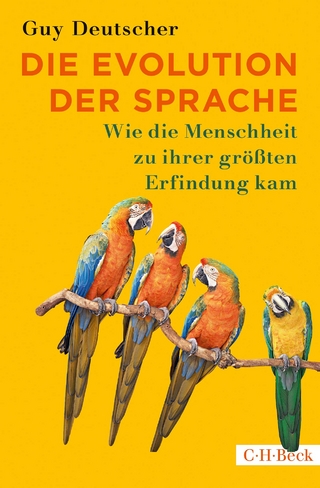
Theory of Language
Benjamins (John) North America Inc.,US (Verlag)
978-1-55619-200-5 (ISBN)
1. Editor's Introduction: Kari Buhler: Sematologist; 2. Translator's Preface; 3. Preface; 4. Introduction: Theory of Language Yesterday and Today; 5. 0. Historical Works; 6. 1. Paul's "Principles of the History of Language": Dependency on Descartes - Natural sciences and history; 7. 2. Saussure's Cours: Substance-oriented thought in the 19th century; 8. 3. Husserl's programme in the "Logical Investigations"; 9. I. The Principles of Language Research; 10. 1. The Idea and Plan of the Axiomatics; 11. 1.0 Observations and the ideas guiding research; 12. 1.1 Exact recordings: three manners of understanding; 13. 1.2 Initial object of linguistic research: the conceptual world of the linguistic researcher; 14. 1.3 Axioms of language research; 15. 1.4 The four principles; 16. 2. The Model of Language as Organon (A); 17. 2.0 Manners of appearance of the concrete speech event; 18. 2.1 Inadequacy of the causal view of substance-oriented thought; 19. 2.2 The new model: the three semantic functions of language; 20. 2.3 Expression and appeal as independent variables in addition to representation: the three books on language; 21. 3. The Significative Nature of Language (B); 22. 3.0 The constructive model of language; 23. 3.1 The etyma of the words for sign; 24. 3.2 Direct analysis of the concept of sign: comparative psychology - a general formula; 25. 3.3 "Aliquid stat pro aliquo": two determinations; 26. 3.4 The principle of abstractive relevance, illustrated by phonology; 27. 3.5 The problem of abstraction; 28. 3.6 Two forms of material fallacy; 29. 4. Speech Action and Language Work; Speech Act and Language Structure (C); 30. 4.0 Inadequacy of previous dichotomies: the four-celled pattern; 31. 4.1 Speech action and language work: empractical speech - la parole; 32. 4.2 The work of art in language: the theory of speech action; 33. 4.3 The structures in language: criticism - structural survey in linguistics - the higher level of formalization - comparisons outside the linguistic realm - intersubjectivity; 34. 4.4 Theory of speech acts - Steinthal and Husserl: appreciation of Husserl's theory of acts - the social factor in language; 35. 5. Word and Sentence: The S-F-System of the Type Language (D); 36. 5.0 The features of the concept of language; 37. 5.1 Analysis of a one-class system of communicative signals; 38. 5.2 The two-class system language: the dogma of lexicon and syntax; 39. 5.3 The productivity of field systems; 40. 5.4 Logic and linguistics; 41. II. The Deictic Field of Language and Deictic Words; 42. Introduction; 43. The signpost and the speech action; 44. The deictic field - modes of deixis; 45. Wegener and Brugmann as predecessors; 46. Speech about perceptual things; 47. Psychological analysis; 48. 6. The Psychological Foundations of the Modes of Positional Deixis in Indo-European; 49. 6.0 Brugmann's modes of deixis and the general problem; 50. 6.1 The myth of the deictic origin of language; 51. 6.2 *to-deixis and ille-deixis; 52. 6.3 The second and third deictic mode; 53. 6.4 Natural deictic clues; 54. 6.5 Quality of origin and the acoustic characterization of the voice; 55. 6.6 Directions in thou-deixis and istic-deixis; 56. 6.7 Yonder-deixis; 57. 6.8 A general question; 58. 7. The Origin of the Deictic Field and its Mark; 59. 7.0 The here-now-I system of subjective orientation; 60. 7.1 The meaning of the deictic words from a logical perspective; 61. 7.2 The words for 'here' and 'I' as cognates; 62. 7.3 The indispensability of deictic clues; 63. 7.4 The role of 'I' and 'thou'; 64. 7.5 The usual classification of the pronouns: criticism; 65. 7.6 The necessity of demonstration; 66. 8. Imagination-Oriented Deixis and the Anaphoric Use of Deictic Words; 67. 8.0 The second and third modes of deixis; 68. 8.1 Ocular demonstration and imagination-oriented deixis as a psychological problem; 69. 8.2 Subjective orientation when awake and its components; 70. 8.3 Spatial orientation and deictic speech; 71. 8.4 Movement of the origo in the tactile bodily image; 72. 8.5 Temporal orientation; 73. 8.6 The three types of imagination-oriented deixis; 74. 8.7 Psychological reduction; 75. 8.8 Displacements: dramatic and epic procedure; 76. 9. Egocentric and Topomnestic Deixis in Various Languages; 77. 9.0 The deictic field; 78. 9.1 The inclusive and exclusive 'we'; 79. 9.2 Coalescence of deictic particles with prepositions; 80. 9.3 Egocentric and topomnestic deixis: the class of 'prodemonstratives' - examples from Japanese and Amerindian languages
| Reihe/Serie | Foundations of Semiotics ; 25 |
|---|---|
| Übersetzer | Donald Fraser Goodwin |
| Sprache | englisch |
| Maße | 164 x 245 mm |
| Gewicht | 910 g |
| Themenwelt | Schulbuch / Wörterbuch ► Wörterbuch / Fremdsprachen |
| Geisteswissenschaften ► Philosophie ► Sprachphilosophie | |
| Geisteswissenschaften ► Sprach- / Literaturwissenschaft ► Sprachwissenschaft | |
| ISBN-10 | 1-55619-200-2 / 1556192002 |
| ISBN-13 | 978-1-55619-200-5 / 9781556192005 |
| Zustand | Neuware |
| Haben Sie eine Frage zum Produkt? |
aus dem Bereich


